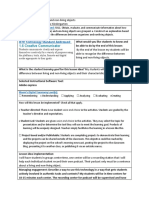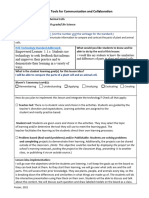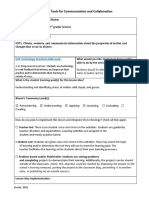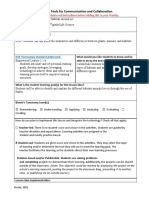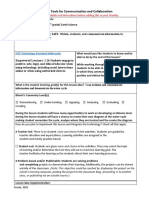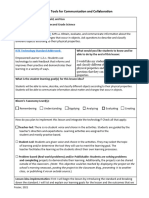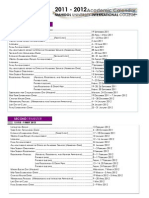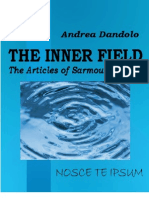Web 2
Web 2
Uploaded by
api-644885574Original Description:
Original Title
Copyright
Available Formats
Share this document
Did you find this document useful?
Is this content inappropriate?
Report this DocumentCopyright:
Available Formats
Web 2
Web 2
Uploaded by
api-644885574Copyright:
Available Formats
Web 2.
0 Tools for Communication and Collaboration
Lesson Idea Name: Living and Nonliving Organisms
Grade Level/Content Area: Kindergarten/Science
Content Standard Addressed: SKL1.a Construct an explanation based on observations to
recognize the differences between organisms and nonliving objects.
ISTE Technology Standard Addressed: What would you like students to know and
Empowered Learner be able to do by the end of this lesson:
1.1.c. Students use technology to seek Construct an explanation based on
feedback that informs and improves their observations. Recognize the differences
practice and to demonstrate their learning in a between organisms and nonliving objects.
variety of ways.
What is the student learning goal(s) for this lesson idea?
I can identify and explain the differences between organisms and nonliving objects.
Bloom’s Taxonomy Level(s):
☒ Remembering ☒ Understanding ☒ Applying ☐ Analyzing ☐ Evaluating ☐
Creating
I will promote students learning to a higher level of blooms by having students analyze the
items in their house and draw a picture of one living and one nonliving thing they find.
How do you plan to implement this lesson and integrate the technology? Check all that apply:
X Teacher-led: There is no student voice and choice in the activities. Students are guided by
teacher direction and expectations. Learning activities are assigned to the
student and mostly practice based.
☐ Stu
dent-Led: Students are given voice and choice in the activities. They may select the topic
of learning and/or determine the tool they will use to meet the learning goal. The
teacher facilitates the learning as the students direct their own learning processes.
☐ Problem-based and/or Publishable: Students are solving problems
and completing projects to demonstrate their learning. Additionally, the projects can
be shared outside of the classroom. (Note: This objective could be reached
by displaying the project on the school’s morning newscast, posting the project to the
classroom blog, presenting it to another class, or publishing via an outside source.)
Lesson idea implementation:
Before completing the activity at home the students learning goals will be written down and
explained verbally, a copy of these goals will also be sent home with the students. We
provided the students with images on padlet of living and non-living things and asked the
students what they believe is living and non-living. This allows them to use their prior
knowledge to show the level of understanding that they have on the subject at hand. During
Frazier, 2021
Web 2.0 Tools for Communication and Collaboration
the lesson our students will be requested to watch a short clip on living and non-living things
on BrainPOP and then assigned to draw one living and non-living thing on the padlet. By the
end of this lesson students will be able to answer the following questions: “What is a living
thing?”/“What makes something living?” and “What is a non-living thing?”/“What makes
something non-living?”. We will use flippity to create a matching game for students to match
living and non-living things together. Finally, students will be able to rate whether they
enjoyed the lesson or not by giving a thumbs up or thumbs down on the padlet post.
Managing student learning: This lesson will be complete at home with the help of the
students parents. They will have as much time as they need to complete the lesson.
Universal Design for Learning (UDL):
The activities planned enhances the students learning experience because it guides student
step by step through the lesson. Padlet supports engagement components of the UDL
framework by allowing videos, audios, and pictures to be implemented throughout the lesson
that help guide students through the lesson, it will be hard for them to get lost.
Reflective Practice:
I feel that they activities created will meet a variety of learning styles and keep the students
engaged throughout the lesson. As the lesson is provided with step by step instructions in
which the students are able to pause, play, and rewind. I look forward to seeing all of the
students drawings, they should be interesting to decipher.
Frazier, 2021
You might also like
- 2010 Assessment Moderation Video ConfDocument10 pages2010 Assessment Moderation Video ConfDavid PawleyNo ratings yet
- Web 2.0 Communcation and CollaborationTools) LESSON IDEADocument2 pagesWeb 2.0 Communcation and CollaborationTools) LESSON IDEAkatherineNo ratings yet
- Web 2.0 Communcation and CollaborationTools) LESSON IDEA TEMPLATE 1Document2 pagesWeb 2.0 Communcation and CollaborationTools) LESSON IDEA TEMPLATE 1chandlerjordan123No ratings yet
- Web 2Document2 pagesWeb 2api-653298500No ratings yet
- Web 2Document3 pagesWeb 2api-653328456No ratings yet
- Web 2Document2 pagesWeb 2api-632156750No ratings yet
- Web 2.0 Tools For Communication and Collaboration: Content Standard AddressedDocument2 pagesWeb 2.0 Tools For Communication and Collaboration: Content Standard Addressedapi-691388495No ratings yet
- Lesson Plan MultimediaDocument2 pagesLesson Plan Multimediaapi-631921849No ratings yet
- BPT LessonDocument3 pagesBPT Lessonapi-723401996No ratings yet
- Web 2Document2 pagesWeb 2api-724760203No ratings yet
- Life Cycle of A Butterfly Lesson PlanDocument2 pagesLife Cycle of A Butterfly Lesson Planapi-695147432No ratings yet
- Harriet Amihere Multimedia Audio or Video Lesson Idea Template2022Document3 pagesHarriet Amihere Multimedia Audio or Video Lesson Idea Template2022api-674932502No ratings yet
- Mod 7 Lesson Plan Communication and CollaborationDocument2 pagesMod 7 Lesson Plan Communication and Collaborationapi-653469285No ratings yet
- Web 2Document2 pagesWeb 2api-723689246No ratings yet
- Web 2Document2 pagesWeb 2api-631522404No ratings yet
- Communication and Collaboration LessonDocument2 pagesCommunication and Collaboration Lessonapi-618492936No ratings yet
- Web 2Document2 pagesWeb 2api-631444394No ratings yet
- Aria Latour - Communication and Collaboration LessonDocument2 pagesAria Latour - Communication and Collaboration Lessonapi-724267574No ratings yet
- Living Things Lesson PlanDocument2 pagesLiving Things Lesson Planapi-727221104No ratings yet
- Web 2Document3 pagesWeb 2api-653292818No ratings yet
- Web 2Document2 pagesWeb 2api-653326359No ratings yet
- Web 2Document3 pagesWeb 2api-654223431No ratings yet
- Web 2Document2 pagesWeb 2api-631567161No ratings yet
- 2023 Web 2Document3 pages2023 Web 2api-653200776No ratings yet
- Bpts Lesson Idea LWDocument2 pagesBpts Lesson Idea LWapi-657408178No ratings yet
- Multimedia LessonDocument2 pagesMultimedia Lessonapi-723401996No ratings yet
- Web 2Document3 pagesWeb 2api-724269635No ratings yet
- Bpts Basic Productivity Tools Lesson Idea TemplateDocument2 pagesBpts Basic Productivity Tools Lesson Idea Templateapi-724754309No ratings yet
- Multimedia Audio or Video Lesson Idea Template2022Document3 pagesMultimedia Audio or Video Lesson Idea Template2022api-689979439No ratings yet
- Bpts Basic Productivity ToolsDocument3 pagesBpts Basic Productivity Toolsapi-691280108No ratings yet
- Web 2Document2 pagesWeb 2api-630987017No ratings yet
- Multimedia Audio or Video Lesson Idea Template2022Document3 pagesMultimedia Audio or Video Lesson Idea Template2022api-689797715No ratings yet
- Bpts Basic Productivity Tools Lesson Idea TemplateDocument2 pagesBpts Basic Productivity Tools Lesson Idea Templateapi-690637749No ratings yet
- Web 2Document2 pagesWeb 2api-690395149No ratings yet
- Basic Productivity Presentation Tool Lesson IdeaDocument3 pagesBasic Productivity Presentation Tool Lesson Ideaclairebutcher219No ratings yet
- Basic Productivity Tools LessonDocument3 pagesBasic Productivity Tools Lessonapi-723689246No ratings yet
- NG - Web 2Document2 pagesNG - Web 2api-652952928No ratings yet
- Web 2.0 Communcation and Collaboration Tools Lesson IdeaDocument3 pagesWeb 2.0 Communcation and Collaboration Tools Lesson IdeaSarah SkibickiNo ratings yet
- Basic Productivity Tools Science Lesson Idea - RominaDocument2 pagesBasic Productivity Tools Science Lesson Idea - Rominaapi-690855466No ratings yet
- Web 2Document3 pagesWeb 2api-726172812No ratings yet
- BPT m6 Lesson 1Document2 pagesBPT m6 Lesson 1api-523795815No ratings yet
- Bpts Basic Productivity Tools Lesson Idea Template 1Document3 pagesBpts Basic Productivity Tools Lesson Idea Template 1api-724760203No ratings yet
- Basic Productivity Tool Lesson PlanDocument3 pagesBasic Productivity Tool Lesson Planapi-691363256No ratings yet
- Web 2Document2 pagesWeb 2api-690524560No ratings yet
- Web 2.0 Communcation - and - CollaborationTools) Lesson PlanDocument3 pagesWeb 2.0 Communcation - and - CollaborationTools) Lesson PlanravenNo ratings yet
- Bpts Basic Productivity Tools-Erin IsbellDocument2 pagesBpts Basic Productivity Tools-Erin Isbellapi-724175639No ratings yet
- m06 Beyond The Basic Prductivity Tools Lesson Idea TemplateDocument2 pagesm06 Beyond The Basic Prductivity Tools Lesson Idea Templateapi-515035362No ratings yet
- Nicholas Mansour Web 2Document2 pagesNicholas Mansour Web 2api-691736066No ratings yet
- Web 2Document2 pagesWeb 2api-619046899No ratings yet
- m06 Beyond The Basic Prductivity Tools Lesson Idea Template Madison SwannDocument2 pagesm06 Beyond The Basic Prductivity Tools Lesson Idea Template Madison Swannapi-515409672No ratings yet
- Itech Lesson 1Document4 pagesItech Lesson 1api-654275072No ratings yet
- Beyond-the-Basic Productivity Tools (BBPT)Document2 pagesBeyond-the-Basic Productivity Tools (BBPT)api-554191151No ratings yet
- Itec 3100 - Basic Productivity Tool Lesson PlanDocument3 pagesItec 3100 - Basic Productivity Tool Lesson Planapi-733331222No ratings yet
- Web 2Document2 pagesWeb 2api-651798464No ratings yet
- Web 2Document2 pagesWeb 2api-692395377No ratings yet
- BPT Lesson PlanDocument2 pagesBPT Lesson Planapi-690363359No ratings yet
- Web 2Document2 pagesWeb 2api-724202200No ratings yet
- Web 2Document3 pagesWeb 2api-727669937No ratings yet
- Web 2Document2 pagesWeb 2api-653336905No ratings yet
- Lesson Plan For ItecDocument2 pagesLesson Plan For Itecapi-724476036No ratings yet
- Proposed 2021-2022 School CalendarDocument2 pagesProposed 2021-2022 School CalendarMatt PapaycikNo ratings yet
- Level of Satisfaction of The 2 Year BSMT Students On The Full Mission Simulation at UCLMDocument15 pagesLevel of Satisfaction of The 2 Year BSMT Students On The Full Mission Simulation at UCLMRuiz, Cherryjane100% (1)
- DETAILED LESSON PLAN - CSS (IDEA FORMAT) SampleDocument6 pagesDETAILED LESSON PLAN - CSS (IDEA FORMAT) Sample신앙선생No ratings yet
- The Analysis of Hysteria 2nd EditionDocument488 pagesThe Analysis of Hysteria 2nd EditionJelena JovanovicNo ratings yet
- Academic CalendarDocument2 pagesAcademic CalendarSiravich KhongrodNo ratings yet
- FS 3 Episode 1: The School's Learning Resource CenterDocument10 pagesFS 3 Episode 1: The School's Learning Resource CenterJonnah Lee100% (1)
- Chapter 1Document20 pagesChapter 1Kim2x TamparongNo ratings yet
- Content and Language Integrated Learning (CLIL) : A European OverviewDocument8 pagesContent and Language Integrated Learning (CLIL) : A European OverviewEnrique Gomez OrtegaNo ratings yet
- Sarmoung's Blog Vol 1 (The Articles of Sarmoung'sBlog)Document157 pagesSarmoung's Blog Vol 1 (The Articles of Sarmoung'sBlog)MisterSarmoung100% (4)
- Silliman ScholarshipDocument3 pagesSilliman ScholarshipeyoooyaNo ratings yet
- Ped 16 (Reviewer)Document11 pagesPed 16 (Reviewer)Kiara SaldariegaNo ratings yet
- Algebra and Trigonometry 8th Edition Aufmann Solutions Manual Full Chapter PDFDocument67 pagesAlgebra and Trigonometry 8th Edition Aufmann Solutions Manual Full Chapter PDFmatthewjordankwnajrxems100% (14)
- Industry 4.0Document6 pagesIndustry 4.0suraj kumarNo ratings yet
- Turnover Rates in Heterogeneous CatalysisDocument6 pagesTurnover Rates in Heterogeneous CatalysisWahab ChodharyNo ratings yet
- Write NA If No Information Is Available in The Resume. First Name Middle NameDocument3 pagesWrite NA If No Information Is Available in The Resume. First Name Middle NameChace CrawfordNo ratings yet
- Kehidne TimilehinDocument2 pagesKehidne TimilehintimilehinNo ratings yet
- Profile of Bicol Sucs: Basis For Policy RecommendationDocument9 pagesProfile of Bicol Sucs: Basis For Policy RecommendationjournalNo ratings yet
- Join Our Global Team: Engineer, Technology (Temporary Employment For Project)Document3 pagesJoin Our Global Team: Engineer, Technology (Temporary Employment For Project)ssrrrpppNo ratings yet
- Textbook Evaluating Campus Climate at Us Research Universities Opportunities For Diversity and Inclusion Krista M Soria Ebook All Chapter PDFDocument43 pagesTextbook Evaluating Campus Climate at Us Research Universities Opportunities For Diversity and Inclusion Krista M Soria Ebook All Chapter PDFwilliam.pugh239100% (13)
- UntitledDocument383 pagesUntitledoutdash2100% (1)
- Applying STAR Strategy To Improve Students' VocabularyDocument8 pagesApplying STAR Strategy To Improve Students' VocabularybudiarmanNo ratings yet
- RPS English For PhysicsDocument10 pagesRPS English For PhysicsMeta SariNo ratings yet
- TelebreakDocument404 pagesTelebreakokhtayNo ratings yet
- AI ManualDocument69 pagesAI ManualDev SejvaniNo ratings yet
- DefinitionDocument2 pagesDefinitionVictor CharlesNo ratings yet
- 2024 KZN Lo Subject Improvement PlanDocument22 pages2024 KZN Lo Subject Improvement Plangugulethutembe3No ratings yet
- Best Jobs in ITDocument5 pagesBest Jobs in ITAruarak AlbahariNo ratings yet
- 1 - Prospectus Higher Degree (2013)Document111 pages1 - Prospectus Higher Degree (2013)Lavanya TheviNo ratings yet
- Tony Farinaro ResumeDocument1 pageTony Farinaro Resumeapi-285526401No ratings yet








